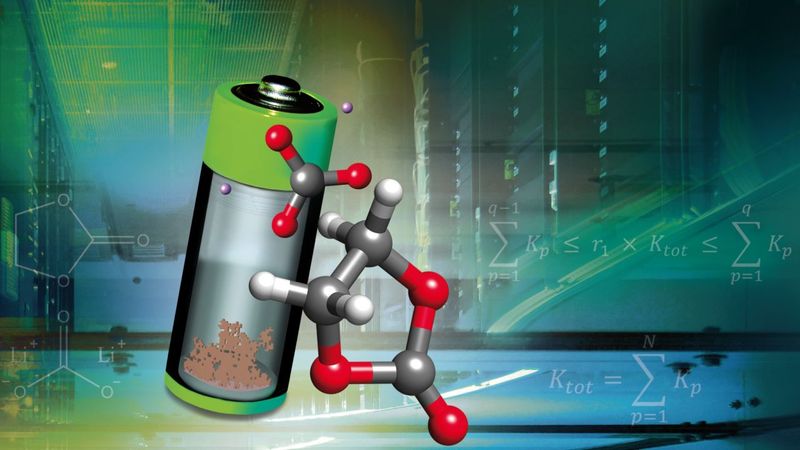Batteries: Major Mystery of the Passivation Layer Solved
KIT researchers characterize the chemical processes at the electrodes of lithium-ion batteries by means of simulations

KIT researchers have characterized the formation of the solid-electrolyte interface with the help of simulations. (Collage: Christine Heinrich)
Lithium-ion batteries have become an integral part of our everyday life. They only work with a passivation layer that forms on the electrodes during the first charging process. As researchers at the Karlsruhe Institute of Technology (KIT) have now determined using simulations, this solid-electrolyte interface does not form directly at the electrode, but rather grows out of the solvent. The scientists report on their study in the journal Advanced Energy Materials ( DOI: 10.1002/aenm.202203966 ). Their findings make it possible to optimize the performance and service life of future batteries.
From smartphones to electric cars – lithium-ion batteries are used almost everywhere where mobile power supply is required. The solid electrolyte interphase (SEI) is crucial for the reliable operation of these and other liquid electrolyte batteries. This passivation layer forms when a voltage is first applied. The electrolyte is decomposed in the immediate vicinity of the surface. It was previously unclear how the components of the electrolyte can form a stable layer up to 100 nanometers thick on the surface of the electrodes when the decomposition reaction is only possible within a few nanometers of the surface.
The passivation layer on the anode surface plays a key role in determining the electrochemical performance and service life of a lithium-ion battery, because it is heavily stressed in every charging and discharging cycle. If the SEI breaks open, the electrolyte is further decomposed and the capacity of the battery steadily decreases - a process that determines the life of the battery. With the appropriate knowledge about the growth and composition of the SEI, battery properties can be specifically adapted. So far, however, neither experimental nor computer-aided approaches have succeeded in decoding these complex growth processes, which take place on very different sizes and length scales.
Study within the EU initiative BATTERY 2030+
Researchers at the Institute of Nanotechnology (INT) of the KIT have now managed to characterize the formation of the SEI with a multi-scale approach. "We have thus solved one of the great mysteries of the most important interface in liquid electrolyte batteries - also in lithium-ion batteries, as we all use them every day," says Professor Wolfgang Wenzel, head of the "Multiscale Materials Modeling and Virtual Design" research group INT. The Karlsruhe researchers report on their findings in the journal Advanced Energy Materials . The research group is involved in the large-scale European research initiative BATTERY 2030+, which aims for safe, affordable, long-lasting and sustainable high-performance batteries for the future.
More than 50 000 simulations for different reaction conditions
To study the growth and composition of the passivation layer on the anode of liquid-electrolyte batteries, researchers at INT created a set of more than 50,000 simulations representing different reaction conditions. They found that the formation of the organic SEI occurs via a solution-mediated pathway: first, SEI precursors formed directly on the surface, far from the electrode surface, self-assemble via nucleation. The nuclei then grow so quickly that a porous layer forms, which finally covers the electrode surface. This finding explains the paradoxical situation that the SEI can only form near the surface where electrons are available, but without the observed mechanism would stop growing immediately when this small area near the electrode is filled. "We have identified those reaction parameters that determine the thickness of the passivation layer," explains Dr. Saibal Jana, postdoc at INT and one of the authors of the study. "In the future, this will make it possible to develop electrolytes and suitable additives to control the properties of the SEI and thus improve the performance and lifetime of the batteries."
Original publication (Open Access)
Meysam Esmaeilpour, Saibal Jana, Hongjiao Li, Mohammad Soleymanibrojeni, and Wolfgang Wenzel: A Solution-Mediated Pathway for the Growth of the Solid Electrolyte Interphase in Lithium-Ion Batteries. Advanced Energy Materials, 2023. DOI: 10.1002/aenm.202203966